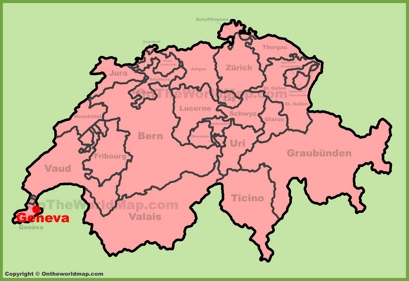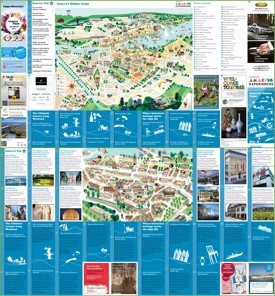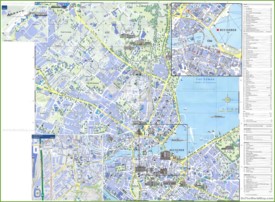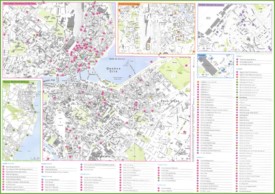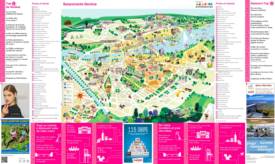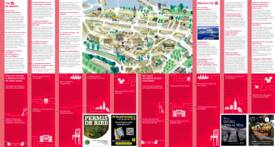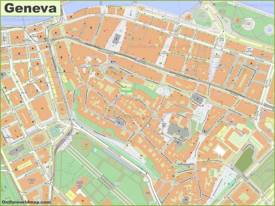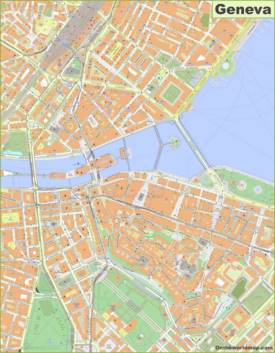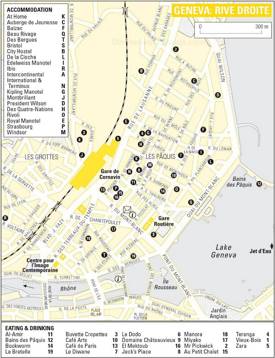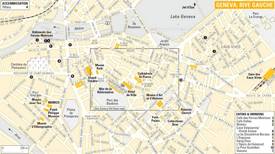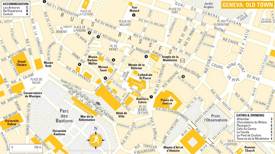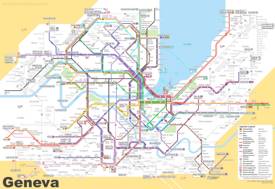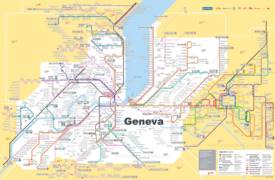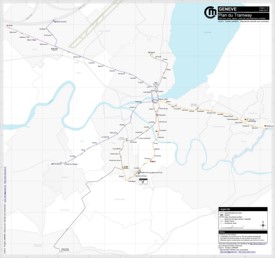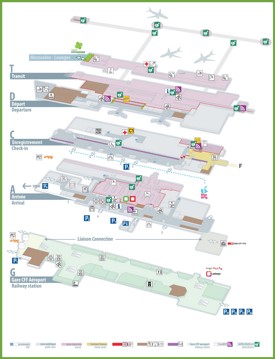Map of Geneva
Description:
This map shows streets, museums, monuments, leisure, parks, business, education, transport, points of interest, tourist attractions, and sightseeings in Geneva.
Author: Genève Tourisme www.geneve.com
You may download, print or use the above map for educational, personal and non-commercial purposes. Attribution is required. For any website, blog, scientific research or e-book, you must place a hyperlink (to this page) with an attribution next to the image used.
Online Map of Geneva
About Geneva
Geneva, known as Genève in French, is a city rich in history, culture, and international significance. It is the second-most populous city in Switzerland and serves as the capital of the Republic and Canton of Geneva. Nestled at the southwestern tip of Lake Geneva (Lac Léman), the city is surrounded by the Jura mountains and the French Alps, offering stunning natural beauty.

Geneva is located in the French-speaking part of Switzerland. The city covers an area of approximately 15.93 square kilometers (6.15 square miles). It is strategically positioned at the confluence of the Rhône River and Lake Geneva, which provides a picturesque waterfront and numerous recreational opportunities. As of the latest statistics, Geneva has a population of 206,635[1] people within the city limits, with a metropolitan area population of about 950,000. The city is known for its cosmopolitan atmosphere, with a significant expatriate community and residents from various cultural backgrounds.

Geneva is a global financial center, renowned for its private banking sector and the presence of numerous international organizations. The city's economy is diverse, with key industries including finance, technology, trade, and diplomacy. The presence of international bodies such as the World Trade Organization (WTO) and the World Health Organization (WHO) further enhances its economic profile. Geneva is well-connected through an efficient public transportation system, including trams, buses, and trains. The city's international airport, Geneva Airport, provides flights to numerous global destinations, making it a convenient hub for international travel.

Geneva is one of the most popular destinations for tourists from all over the world. Here you will find stunning natural beauty along with urban appeal. Here's a guide to some of the most notable attractions and activities that make Geneva a must-see city.
Jet d'Eau
The Jet d'Eau is a famous fountain in Geneva, located where Lake Geneva meets the Rhône River. It propels water 140 meters (460 feet) into the air and was originally installed in 1886 as a safety valve. Now a decorative feature since 1891, it operates year-round, except during adverse weather, and is illuminated at night. As a symbol of Geneva, the Jet d'Eau attracts many tourists and is a popular subject for photography.




Lake Geneva and Boat Cruises
Lake Geneva, one of the largest lakes in Western Europe, offers numerous recreational opportunities. Tourists can take scenic boat cruises to explore the lake and enjoy views of the surrounding mountains. The lake is also popular for swimming, sailing, and windsurfing.


The United Nations Office at Geneva
Geneva is home to the European headquarters of the United Nations. The Palais des Nations, set in the picturesque Ariana Park, is open for guided tours. Visitors can learn about the history and work of the UN and see important rooms such as the Assembly Hall and the Council Chamber.
The Old Town (Vieille Ville)
The Old Town (Vieille Ville) of Geneva is a charming historic district that serves as the cultural and historical heart of the city. Characterized by its narrow cobblestone streets and picturesque squares, the area is home to numerous landmarks, including St. Peter's Cathedral, where John Calvin preached during the Protestant Reformation. Visitors can explore a variety of museums, art galleries, and antique shops nestled among the ancient buildings.
Key attractions include the Maison Tavel, the oldest house in Geneva, which now serves as a museum, and the picturesque Place du Bourg-de-Four, a lively square with cafes and shops. The Old Town offers a glimpse into Geneva's rich past and is a popular destination for both tourists and locals seeking to experience the city's heritage and atmosphere.


The Reformation Wall
Located in the Parc des Bastions, the Reformation Wall is a monument commemorating the leaders of the Protestant Reformation. Erected in 1909, the wall features statues of prominent figures like John Calvin and William Farel. It reflects Geneva's significant role in the Reformation movement.
The Museum of Art and History
Geneva boasts a vibrant cultural scene, and the Museum of Art and History is its largest museum. It houses an extensive collection of artworks, archaeological artifacts, and applied arts. The museum offers a comprehensive overview of Western culture from prehistoric times to the present day.
CERN
For science enthusiasts, a visit to CERN, the European Organization for Nuclear Research, is a must. Located just outside Geneva, CERN is the world's largest particle physics laboratory. Visitors can take guided tours to learn about groundbreaking research, including the famous Large Hadron Collider.
Parc des Bastions
This beautiful park is not only home to the Reformation Wall but also offers a tranquil escape in the heart of the city. Visitors can enjoy a leisurely stroll, play giant chess, or relax at the café. The park also hosts various cultural events throughout the year.
The Patek Philippe Museum
Geneva has a long-standing tradition of watchmaking, and the Patek Philippe Museum showcases this heritage. The museum displays an impressive collection of timepieces, including antique watches and clocks, as well as exhibits on the history of watchmaking.

Basilica of Our Lady of Geneva (Basilica Notre-Dame)
The Basilica of Our Lady of Geneva, was constructed between 1852 and 1857 and is situated near the Cornavin train station. The basilica was designed by architect Alexandre Grigny in the neo-Gothic style, characterized by its pointed arches, ribbed vaults, and flying buttresses. The church was elevated to the status of a minor basilica by Pope Pius XII in 1954. It serves as an important place of worship and a center for the Catholic community in Geneva. The basilica is renowned for its beautiful stained glass windows and its impressive pipe organ, which is often used for concerts and religious services.

Russian Church, Geneva
The Russian Church, officially known as the Cathedral of the Exaltation of the Holy Cross, is a Russian Orthodox church located in Geneva, Switzerland. It was built between 1863 and 1866, primarily funded by donations from the Russian community and Swiss converts to Orthodoxy, with significant contributions from the Russian royal family, including Grand Duchess Anna Fyodorovna. The church was designed by Swiss architect David Grimm and is noted for its striking Byzantine Revival architecture, featuring ornate onion domes covered in gold leaf. The interior is richly decorated with traditional Orthodox iconography, frescoes, and a beautiful iconostasis. The Russian Church in Geneva serves as a spiritual and cultural hub for the Russian Orthodox community in the region and remains an important symbol of Russian heritage in Switzerland.

The confluence of the Rhône and Arve
The confluence of the Rhône and Arve rivers is a striking natural feature in Geneva. At this point, the clear blue waters of the Rhône meet the milky, silt-laden waters of the Arve, creating a distinct visual contrast. The Rhône originates from the Rhône Glacier in the Swiss Alps, while the Arve flows from the Mont Blanc massif in France. This confluence is a popular spot for visitors, offering scenic views and opportunities for photography. It also serves as an important ecological area, supporting diverse habitats.

Carouge
Just a short tram ride from the city center, Carouge is a charming neighborhood with a distinct Mediterranean feel. Known for its bohemian atmosphere, Carouge features artisanal shops, cafes, and a lively market. It's a great place to explore and experience a different side of Geneva.
Parc La Grange
Parc La Grange is a prominent public park, near the shores of Lake Geneva. Covering approximately 21 hectares, it is one of the largest and most beautiful parks in the city. The park is known for its expansive lawns, scenic views, and diverse botanical features, including a renowned rose garden with over 200 varieties of roses.
Parc La Grange also houses the historic Villa La Grange, an 18th-century mansion that has hosted notable events and dignitaries, including the 2021 summit between U.S. President Joe Biden and Russian President Vladimir Putin. The park offers various amenities such as walking paths, playgrounds, and a small animal farm, making it a popular destination for both locals and tourists. In the summer, it hosts outdoor concerts and cultural events, adding to its appeal as a vibrant community space.

More photos of Geneva







Brief History
Geneva, located in southwestern Switzerland, has a history dating back to ancient times. Initially settled by the Celtic Allobroges, it became a Roman settlement in 121 BC. Its strategic location made it a key center for trade during the Middle Ages.
In the 16th century, Geneva was central to the Protestant Reformation, with John Calvin establishing it as a major Protestant hub. The city also became known for its watchmaking industry and Enlightenment thought in the 18th century, with figures like Jean-Jacques Rousseau.
After joining the Swiss Confederation in 1815, Geneva rose to international prominence in the 20th century as a center for diplomacy. It hosted the League of Nations and now serves as the European headquarters of the United Nations, housing organizations like the International Red Cross and the World Health Organization.
The Facts:Canton: Canton of Geneva.
Population (December 2023): 206,635[1].
Metropolitan population: 950,000.
References
1. "Federal Statistical Office.Maps of Switzerland
Cities of Switzerland
Ski Resorts
Cantons of Switzerland


